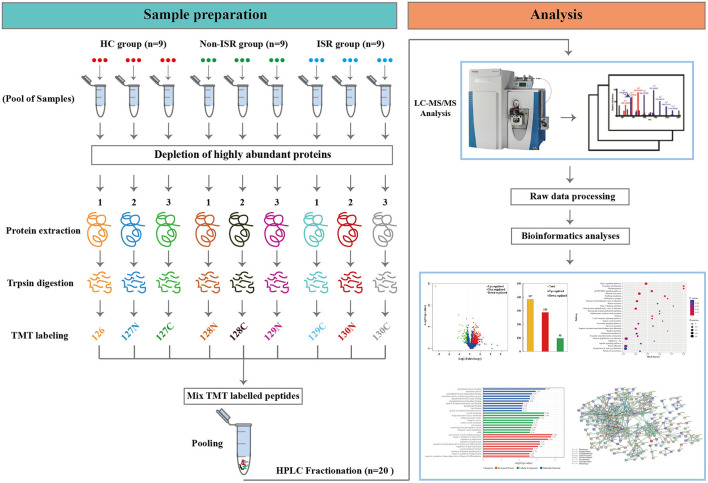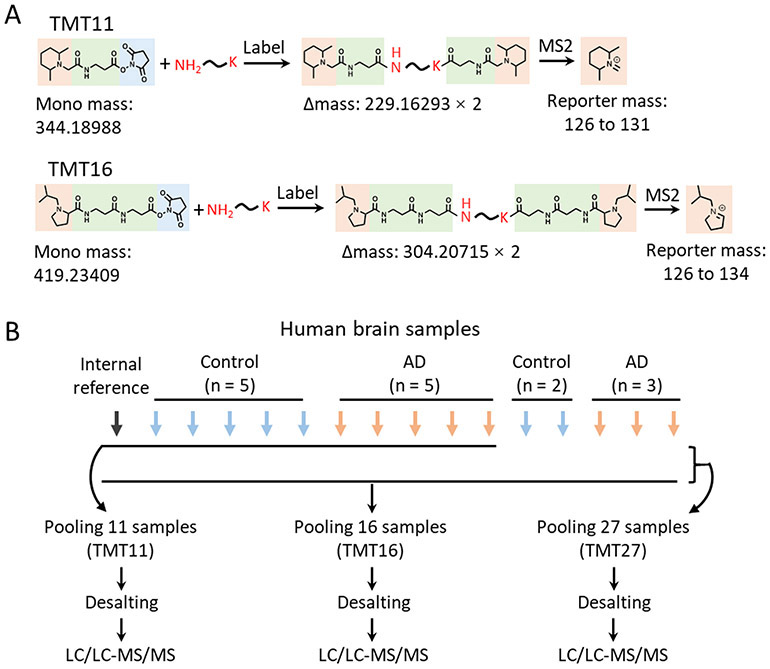TMT Mass Spec Service
TMT Mass Spectrometry Service achieves multi-sample protein quantification through precise multiplex labeling and high-throughput quantitative techniques. It accurately reveals differences in protein expression under various conditions and is widely applied in fields such as tumor proteomics, neuroscience research, drug target screening, and disease biomarker discovery. This service provides efficient and reliable quantitative data support for complex biological processes.

Li, J. et al. Nat Methods. 2020.
Overview of TMTpro Reagents for Sample Multiplexing
TMT mass spectrometry technology is one of the most powerful and efficient quantitative analysis tools in modern proteomics research. By utilizing different mass tags to label proteins in samples, it enables simultaneous quantitative analysis of multiple samples, significantly improving experimental efficiency and reducing the complexity of sample analysis. Compared to traditional protein quantification methods, TMT mass spectrometry can analyze up to 16 samples simultaneously without compromising data quality or experimental efficiency, offering higher sensitivity and better resolution.
One core advantage of TMT mass spectrometry service is its ability to provide precise isotopic labeling quantification, making it particularly suitable for projects that require comparison of protein expression differences across multiple experimental groups. Through this method, researchers can analyze multiple samples within a single experiment, thereby reducing costs and enhancing data reliability. Additionally, TMT mass spectrometry service is highly flexible, accommodating various experimental design needs, including large-scale sample analyses and small-scale targeted studies.
Service at MtoZ Biolabs
MtoZ Biolabs possesses extensive technical expertise and rich service experience in the field of mass spectrometry-based proteomics. We are dedicated to providing high-quality TMT Mass Spec Service to researchers worldwide, covering the entire workflow from sample preparation and mass spectrometry detection to data analysis. We offer personalized solutions tailored to diverse research needs. Leveraging advanced mass spectrometry platforms, including Thermo Fisher Orbitrap Fusion Lumos and Q Exactive HF, along with Nano-LC nanolitre chromatography systems, our TMT Mass Spec Service assist researchers in analyzing protein expression differences between different experimental groups, screening disease-related biomarker proteins, elucidating drug mechanisms of action, and deciphering complex protein interaction networks. Furthermore, we have accumulated extensive application experience in areas such as tumor proteomics, neuroscience research, and drug target screening, enabling us to provide targeted scientific support to our clients.

Hou, J. et al. Front Cardiovasc Med. 2022.
TMT Mass Spectrometry Service Process
Service Advantages
✅ High-Throughput Quantitative Analysis
TMT Mass Spec can analyze up to 16 samples simultaneously, significantly improving experimental efficiency and reducing batch-to-batch variability.
✅ High Sensitivity and Accuracy
Capable of detecting low-abundance proteins, it provides high-resolution and highly accurate quantitative results.
✅ Wide Dynamic Range
Effectively covers the detection of proteins from high to low abundance, ensuring comprehensive data coverage.
✅ One-Time-Charge
Our pricing is transparent, no hidden fees or additional costs.
✅ High-Data-Quality
Deep data coverage with strict data quality control. AI-powered bioinformatics platform integrates all TMT Mass Spec data, providing clients with a comprehensive data report.
Case Study
TMT Mass Spec Aids Precise Quantitative Proteomics Analysis in Alzheimer's Disease
Alzheimer's Disease (AD) is a complex neurodegenerative disorder characterized by neuroinflammation, metabolic dysregulation, and abnormal protein accumulation. Proteomic research is crucial for elucidating the molecular mechanisms of AD and discovering potential biomarkers. In this study, TMT Mass Spec technology was employed for multi-sample quantitative analysis. By combining 11-plex and 16-plex TMT labeling systems, simultaneous detection of 27 samples was achieved. The labeled samples underwent high-pH RPLC fractionation and were then analyzed using an LC-MS/MS platform. Ultimately, multiple proteins with differential expression in the brain tissues of AD patients were identified. The multiplex TMT Mass Spec approach significantly enhanced the depth and throughput of proteomic detection, making it particularly suitable for the quantitative analysis of low-abundance proteins in complex samples.

Wang, Z. et al. Anal Chem. 2020.
Experimental Design for Evaluating TMT27 Method
FAQ
1. How can sample preparation bias be avoided in TMT Mass Spec experiments?
In TMT Mass Spec experiments, sample preparation bias primarily arises from uneven protein extraction and digestion efficiencies. To minimize inter-sample bias and improve the reliability of quantitative data, ensure that all samples are processed under identical conditions regarding buffer composition, digestion time, and temperature. Additionally, incorporating quality control standards for process monitoring can help reduce variability between samples.
2. Does the isotopic labeling effect of TMT Mass Spec impact quantitative accuracy?
Yes, the isotopic labels in TMT Mass Spec can introduce isotopic effects during mass spectrometry detection, leading to slight variations in signal intensities between different tags. These discrepancies can be minimized by using high-resolution mass spectrometers (such as the Orbitrap Fusion Lumos) and optimized algorithms for data correction, thereby reducing the impact of labeling effects on quantitative results to the greatest extent possible.
MtoZ Biolabs, an integrated chromatography and mass spectrometry (MS) services provider.
Related Services
Quantitative Proteomics Service
How to order?







